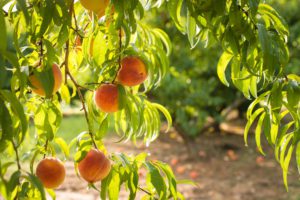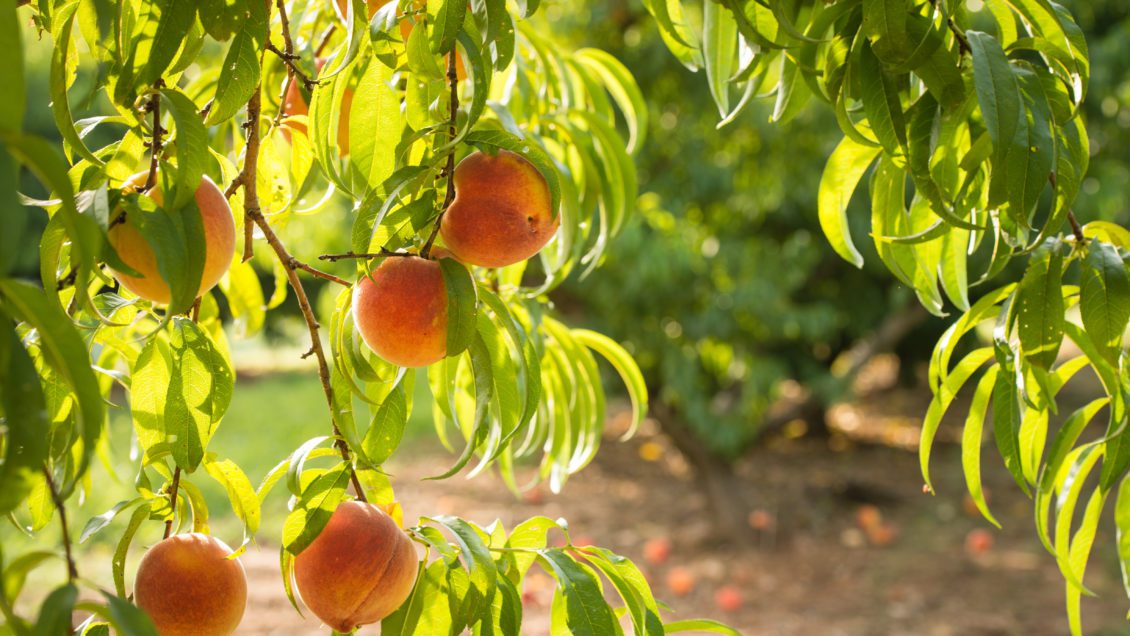This disease is difficult to control and once it makes its way to an orchard, it’s there for the life of that orchard.
– Hehe Wang, Clemson plant bacteriologist/pathologist
With a combined production value of more than $140 million, peaches are a major contributor to agriculture in South Carolina and Georgia. But new strains of a bacterium that causes bacterial spot disease are threatening to choke the life out of peach orchards in these two states.

The bacterium is Xanthomonas arboricola pv. pruni (Xap) and new strains that are resistant to antibiotics and tolerant to copper sprays used to manage bacterial spot have emerged in South Carolina orchards.
A team led by Clemson University researcher Hehe Wang, housed at the Edisto Research and Education Center (REC) in Blackville, has received a $454,996 grant from the United States Department of Agriculture National Institute of Food and Agriculture (USDA-NIFA) to determine how to improve management of this disease and work toward building a disease forecasting system for future growers.
“Annual losses of more than $20 million are estimated during years when the disease is heavy in South Carolina and Georgia,” Wang said. “This disease is difficult to control and once it makes its way to an orchard, it’s there for the life of that orchard. It’s a constant battle.”
The disease has been around for as long as anyone can remember and is more apt to occur during warm, wet spring weather. Information from the National Oceanic and Atmospheric Administration (NOAA) North Carolina Institute for Climate Studies shows the average temperature for South Carolina has increased about 0.5 degrees since the early 20th century.
Historically unprecedented warming, including extreme heat events, is projected by the end of the 21st century. Figures from the NOAA National Centers for Environmental Information show South Carolina spring temperatures and rainfall amounts have been above average for the past several years.
Bacterial spot symptoms on peaches start as water-soaked lesions and develop into light speckles to deep crater lesions at harvest. Bacterial spots on leaves lead to yellowing tips and early defoliation. Severe defoliation could weaken the trees, impact winter hardiness, reduce fruit size, as well as increase sunburn and fruit cracking.
Current disease management mainly relies on weekly spray of copper and an antibiotic (oxytetracycline) throughout the growing season. But new strains resistant to antibiotics and tolerant to copper have emerged. During the study, researchers will determine how current spray programs affect antibiotic resistance and copper-tolerance in Xap and how these new bacteria strains impact efficacy of current spray programs. Copper dosage in sprays decrease as the season progresses.
“We want to learn at what point copper sprays are no longer effective against the copper-tolerant Xap,” Wang said. “We also will study to determine if the copper-tolerant and antibiotic-resistant Xap overwinter on trees to contribute to disease development in the next season and how environmental factors affect their survival.”
Other objectives of the study include identifying genes that make the bacteria resistant to antibiotics and tolerant to copper. The researchers also will evaluate novel chemicals to improve disease management. A fourth objective is to develop a model based on environmental factors during the dormant season to predict inoculum levels for the next growing season. This model will be used in addition to prediction models recently developed for bacterial spot disease development. The researchers believe these models likely could be combined to form a disease forecasting system for the growers in the future.
Peach is a stone fruit. These fruits feature a layer of fleshy, edible pulp surrounding a relatively large, hard pit, or “stone,” that shields and protects a seed. In addition to peaches, other stone fruits include nectarines, plums and cherries. The researchers say this project will benefit peach and other stone fruit growers in the 22 states that contend with bacterial spot, and especially in the seven states where this disease is identified as an Integrated Pest Management (IPM) stakeholder priority.
“Our long-term goal is to increase the sustainability of production of peach and other stone fruits through the development and integration of model-driven disease management strategies,” Wang said. “This project will contribute to potential long-range improvement in sustainability of U.S. agriculture and food systems by sustaining the economic viability of peach and other stone fruit production, satisfying human food needs and enhancing the quality of life for farmers and society as a whole.”
Researchers conducting this study with Wang include Guido Schnabel and Jose Payero from Clemson, Phillip Brannen from the University of Georgia, J.E. Jones and M.A. Paret from University of Florida, S.W. Santra from University of Central Florida, and W.I. Turechek from USDA-Agricultural Research Service.
This grant is one of 15 awarded by USDA-NIFA for studies to determine how to better manage pests and beneficial species that affect agricultural crops. USDA-NIFA officials said this research is needed to help develop better strategies to foster beneficial insects and microbes that have potential to combat pests.
These grants support research to promote beneficial organisms associated with pests, as well as to better understand the fundamental mechanisms that inform interactions between plants, pests, or beneficial species. The officials added this research will lead to innovative, environmentally-sound strategies to manage agricultural pests and beneficial species.
-END-
This study is funded by the United States Department of Agriculture National Institute of Food and Agriculture (USDA-NIFA) Award Number 2021-67013-33574, CU Award Number 0183-207-2014379. Any opinions, findings, and conclusions, or recommendations expressed in this material are those of the authors and do not necessarily reflect the views of the USDA-NIFA.
Related videos
MyIPM – Integrated Pest Management for your smartphone
MyIPM: App for Pest and Disease Management on Fruit Crops
Get in touch and we will connect you with the author or another expert.
Or email us at news@clemson.edu

